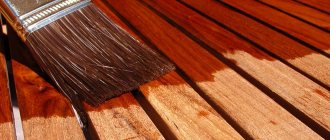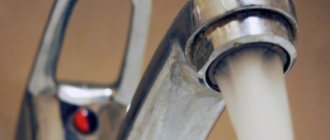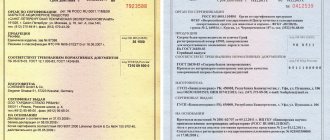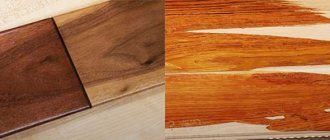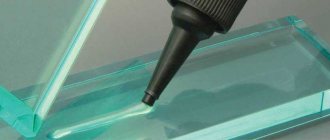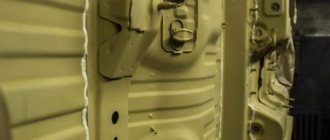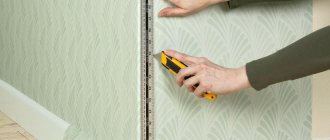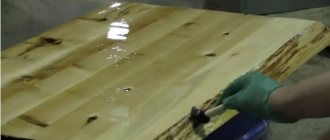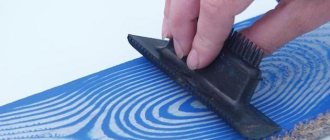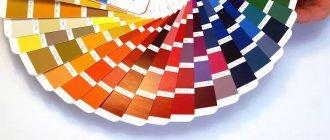Varnish allows you to renew a wooden surface that may deteriorate over time. Many people decide to paint the wood, but in order not to lose the appearance of the natural structure of the wood, it can be varnished.
The varnish coating protects the wood from moisture, mechanical stress, and atmospheric conditions. The products differ in composition, colors and technical characteristics.
How do the compositions differ?
Depending on the operating conditions of the wooden base, the varnish can be used indoors or outdoors. There are compositions that are quick-drying, odorless, frost-resistant, heat-resistant (fire retardant), water-based, oil-based or alcohol-based.
Varnishes come in the following form:
- in cans (aerosol, spray), which are convenient for covering small areas;
- in containers (cans, bottles), applied with a brush, roller, spray gun.
By purpose:
- floor varnishes (parquet);
- for decorating and emphasizing the structure of wood;
- for water transport.
Description
The composition of alkyd varnish includes various synthetic resins, organic solvents and driers. These varnishes have a good adhesion rate and an excellent level of moisture resistance. Nowadays, the use of alkyd varnish is varied; it is used in the following areas:
- for processing end parquet. Since alkyd resins do not allow the ends of parquet dies to stick together, it is alkyd compounds that are used to treat wooden parquet, which prevents the occurrence of surface tension;
- to protect parquet floors where a heated floor system is installed;
- for covering floating floors;
- in order to extend the service life and protect parquet made from rare, delicate types of wood, which are very sensitive to various factors, including temperature and humidity.
Once the alkyd varnish is completely dry, it forms a very durable, hard and transparent protective coating. Some people are hesitant to use alkyd compounds because they think they take a long time to dry. But nowadays, manufacturers have developed special additives that greatly reduce the polymerization time of varnish. Many people are interested in how long does alkyd varnish with drying accelerators take to dry? Final polymerization will take approximately 1-2 days.
When the varnish polymerizes, it produces either a matte or glossy surface, depending on which product was chosen. Wood or metal that is treated with an alkyd solution becomes visually attractive and reliably protected from various negative factors, including chemicals, high humidity, various liquids, etc. Alkyd mixtures are applied very easily and quickly, they have a thick structure, spread well over the surface, while creating a fairly dense coating. One of the effective and popular varnishes is the product of the Kudo company; varnish solutions are produced in the form of aerosols and liquid mixtures.
Varnish colors
The coating can be matte, glossy (with shine), semi-matte and semi-gloss. There are also high-gloss compounds for high shine.
- The most popular transparent varnishes on the market that highlight the natural structure of wood.
- It is possible to give the wood a beige, brown, red, or black color with a walnut shade.
- White varnish and mechagon color make the wood visually more voluminous.
- Tinting varnishes for wood darken the surface, hiding its imperfections. Used for wooden furniture and doors (including interior doors), parquet boards.
Varnishes from the manufacturer
The production of varnishes is one of the areas of production activity of the KrasKo Company . Our products include polymer varnishes for universal use (for concrete, wood, stone, brick, etc.).
Polyurethane varnish Tistrom
— one-component polyurethane-based varnish. The varnish is used for protective and decorative finishing of concrete and mosaic floors, screeds, paving and facing slabs, natural and artificial stone, decorative paving stones, borders.
Polyurethane transparent varnish Tistrom-Decor
- one-component glossy varnish. It is used for protective and decorative finishing of concrete and mosaic floors, screeds, paving and facing slabs, natural and artificial stone, decorative paving stones, borders.
It is also used as a finishing finish for self-leveling floors when sealing decorative chips and various patterns in order to increase the wear resistance of the coating.
Perchlorovinyl varnish Texol
— one-component varnish on a perchlorovinyl base. The varnish is designed to protect concrete, brick, stone, asbestos-cement and other mineral surfaces from corrosion.
Acrylic varnish Drevolak
— one-component acrylic-based varnish. The varnish is intended for protective and decorative finishing of wooden houses, facades, ceilings, pillars, fences, gazebos, garden furniture, ceilings, walls and doors.
Varnishes from the manufacturer - more information about the production of varnishes and polymer varnishes offered to your attention by the KrasKo Company
.
Types of varnishes by composition
The composition determines:
- characteristics of the mixture (drying time, coating thickness, presence or absence of odor);
- conditions of use (for external or internal work).
The price of paintwork depends on these factors, manufacturer and brand.
Oil varnishes for wood
- They are based on oils and resins.
- Dries in 1-3 days.
- Penetrates deeply into the rock.
- For interior work only.
- Process furniture or other wooden objects.
- Not suitable for floor coverings.
The proportion of oil content determines the period of complete hardening of the applied layer.
So, oil varnishes are:
- lean (oil content from 35 to 55%);
- average (from 55 to 65%);
- fatty (from 65 to 85%).
The more oil contained in the composition, the faster the drying, but the greater the susceptibility to wear.
Before applying with a brush, dilute the product to a comfortable consistency, since the mixture is initially too thick.
Artificial resins and oils are now used in production, which has reduced the price of the product. Previously, the composition contained natural oils.
Resin
An ideal alternative to oil based ones. The composition is based on the inclusion of synthetic resins (thermoplastic, thermosetting) and natural (amber).
Alkyd varnishes
They are produced on the basis of alkyd resins, with the addition of solvents (solvent or white spirit) and driers to accelerate drying. Alkyd mixtures are resistant to moisture and temperature changes. They are inexpensive, and their penetration properties into the rock are high.
The applied layer remains on the surface for two to three years. The period of complete polymerization is two days.
Suitable for wooden floors, floating floors, including heated floors, furniture. The compounds are toxic due to the solvent.
It is advisable to work in protective equipment (gloves, respirator).
They are divided into pentaphthalic (PF) and glyphthalic (GF). From the last category, GF-166 and GF-177 are popular. Both representatives have a transparent glossy sheen and harden after 48 hours (GF-177 is faster).
Alcohol
Alcohol varnishes (varnishes) have a narrow scope of application. The composition is based on the content of ethyl alcohol in which the resin is dissolved. This is a quick-drying varnish for wood. Dries in less than 1 hour (20-30 minutes), which is achieved by evaporating the alcohol after applying the layer.
Visually, alcohol mixtures are glossy. Used for coating musical instruments, furniture, leather, glass.
Alkyd-urea
Contains pentaphthalic or glypthal resins, urea. They are two-component and polymerize only after adding an acid-based hardener. Designed for interior work.
They give the surface a strong shine, the coating is highly durable and moisture resistant.
Can be applied to parquet boards or wood floors of any species. They cover indoor furniture.
Epoxy
This is a transparent composition that hardens after adding a hardener to the epoxy resin.
Epoxy varnish on wood is resistant to heavy loads, so it can be used on solid floors, parquet, and can be used to update interior doors or other wooden products.
The composition is moisture resistant and can be used for both interior and exterior work. Dries in half a day.
Polyester
These are multicomponent products based on the inclusion of polyester resins. It is applied with a special gun, so this option is not suitable for beginners. After complete drying, a transparent film of great thickness is formed, which ensures high strength and moisture resistance. Withstands high temperatures and exposure to chemicals.
Wooden musical instruments are usually processed.
Nitrocellulose
Nitrocellulose (or cellulose ether) varnishes contain organic thinners, cellulose nitrate, resins and plasticizers that improve characteristics.
Despite their high resistance to moisture, the mixtures do not withstand atmospheric conditions and do not have great mechanical strength. Over time, the film may peel off from the surface. It can be polished successfully and dries quickly (20-50 minutes).
There are both glossy (NTs-218) and matte (NTs-243) coatings.
Nitrovarnishes are toxic because they contain a solvent. You only need to varnish wood using a respirator and ventilate the room well.
After the solvent has evaporated, the applied layer is safe.
Not used for floors due to weak strength. It is often used to cover wooden furniture, pencils and music. tools. The varnish does not tolerate direct sunlight, so it is better not to use it outside.
Acrylic-urethane
This is a water-soluble, odorless varnish with high adhesion. After drying, the film is resistant to moisture, so you can cover wood in baths, saunas, and apply it in bathrooms. The coating is reliable and durable, does not affect humans, and is safe. It must be used at a temperature not lower than +12 °C, and stored at a temperature below zero, but not less than -5 °C.
Alkyd-urethane
Used as yacht varnishes.
Contains toxic substances (toluene and xylene), the fumes of which affect humans.
This is the best varnish for exterior woodwork, frost-resistant, waterproof, but smells bad. The coating lasts for about five years.
It is not recommended to use indoors. Even after drying, evaporation of substances may continue.
Polyurethane
There are one-component, two- and three-component varnish. The two-component product is prepared before use by mixing with a hardener. The three-component one also contains a solvent.
This is one of the most effective materials in terms of coating strength. But it takes a very long time to dry (2-3 weeks), with a strong pungent odor.
After drying, the layer is resistant to strong mechanical loads, moisture, any atmospheric conditions, chemicals. substances, creates anti-corrosion protection.
External and internal use. Polyurethane varnishes are popular for treating garden structures, yachts and boats, parquet boards, and walls.
Acrylic varnishes
Water-based acrylic varnish provides wood with effective fire protection due to the absence of flammable substances in its composition. These mixtures are odorless, safe for humans, and can be used for opening children's rooms.
They have high adhesion to wood and are vapor permeable, but their strength is not the highest. Water-based varnish is applied only to the primed surface and dries for up to 15 days.
Application is also possible on brick and concrete bases indoors.
Bituminous
Painting wood with bitumen varnish makes it resistant to moisture and acid-base environments.
By default it has a brown tint. The treated surface becomes visually pleasing.
It is applied in a thin layer, and small parts can be coated by dipping.
Tinting mixtures
You can paint a wooden door, furniture, parquet boards. Fulfills a protective and decorative purpose. Visually darkens the wood, giving it the appearance of expensive species, increases the strength of the base and protects against fungus and mold.
Food varnishes
Apply to wooden utensils that come into contact with food. There will be no consequences, the varnish is safe. Suitable for use on cribs and toys.
Perchlorovinyl varnishes
Perchlorovinyl varnishes are solutions of polyvinyl chloride resin in organic solvents, with the addition of components that improve the properties of the varnish. Such varnishes dry quickly enough, have good mechanical properties and water resistance. Perchlorovinyl varnishes are used as protective coatings for concrete, reinforced concrete, brick and other surfaces. The disadvantages of perchlorovinyl varnishes include their low heat resistance and poor gloss.
And, in conclusion, some general recommendations for the use of varnishes:
- It is better to apply two thin layers of varnish than one thick one
- Each new layer of varnish increases the weather resistance of the coating
- in a wooden floor, instead of putty, you can use a mixture of varnish and sawdust to seal the gap
- Most solutions of two-component varnishes (for example, epoxy) are toxic, so when working with them you should use a respirator, goggles and rubber gloves, and the room must be well ventilated
In any case, when purchasing varnish in a store, you need to carefully read the instructions for its use and operating conditions.
What to consider when choosing
The mixture is selected taking into account the conditions of its use.
- Place of work. Indoors, compositions without toxic components and odorless during drying are selected. For external work, only wood varnishes with high resistance to weather conditions (precipitation, sunlight, frost) are suitable. It is permissible to use materials with an unpleasant odor outdoors.
- Wear resistance. Wooden floors and stairs must be coated with varnishes that have high strength and wear resistance. For furniture, you can choose less durable materials, for example, nitrocellulose.
- Toxicity. For indoor use, it is better to choose water-based mixtures. They are odorless, safe, and used without personal protective equipment. You can choose ones that contain toxic substances, but do not forget about a respirator and protective clothing.
- Drying time. If repairs need to be done quickly, water- or oil-based products may not be suitable. They dry out in up to two weeks. While alcohol and NC compositions dry out in 1-2 days.
- Shine. Matte or gloss does not affect the characteristics and quality of the varnish in any way. The choice depends on the person's preferences.
- Curing methods. Mixtures are divided into one-component ones, which are ready for application. And two-component ones, the drying of which begins after reacting with the hardener. It is better for beginners not to use two-component varnishes, since they need to work quickly and be able to maintain the proportions of mixing the components.
- The need for a primer. Priming the wood increases adhesion to the future paint and varnish material. Without preliminary priming, the dried layer may peel off prematurely. There are varnishes on sale with a pre-priming composition.
How to add matte to dye
Are there ways to make a matte varnish from a shiny glossy one? Craftsmen have come up with several ways to create matte varnish at home.
Polishing
This method is often used by car enthusiasts to give a new image to the car; it can be easily matted by polishing and using a glossy floor varnish. Polishing is applied immediately after the varnish for parquet or car body has dried. To cover the floor, you can use the usual polishing products for caring for parquet, and for the car body, it is recommended to purchase a car spray in a can and apply it as indicated in the instructions.
Gasoline use
It is possible to make a glossy varnish matte if you wash the surface with gasoline immediately after drying. But this method is inconvenient because gasoline is flammable and retains a pungent odor for a long time. If the floor varnish coated with gasoline has an alkyd base, the risk of fire increases. In addition, it is difficult to apply gasoline evenly, and the surface will have different shades of dullness after drying.
Adding chalk
Take a glossy regular varnish and add finely crushed chalk to it in an amount of 10% of the volume and mix thoroughly until smooth. It is not recommended to add more than 10% chalk, otherwise, wanting to create a super matte tone, you can only lighten the shine too much, and such a coating may acquire an ugly whitish tint after drying.
Applying a matte chalk solution can only be done with a roller or brush; the aerosol method is not suitable: chalk particles will quickly clog the spray gun nozzle, even if the composition is first filtered.
Use of fine rice flour
Rice flour, like chalk, removes gloss well and is used in the same proportion. Recommended for water-based paints and varnishes. For example, water-based wood varnish with rice flour has no shine after drying and looks silky velvet. Rice flour is also well suited for polymer clay compositions, giving decorative items made from this material a beautiful soft tone. If you don't like the color of the product, you can paint the polymer clay.
Using tooth powder
If you have a sufficient amount of tooth powder at home, then this is also a good way to make a matte tone from a glossy one. Tooth powder contains chalk and some additives. A composition made with tooth powder will cover the surface with an even layer due to the abrasive properties of the additives contained in the powder.
If various additives are introduced into the paint and varnish product, then it is necessary to determine how to apply them: if the aerosol method is acceptable for flour and powder, then if chalk was used, you can only use a brush or roller.
Giving various items a matte finish will help highlight their beauty and provide longer-lasting protection from adverse external factors. Or you can simply quickly update the interior of a room or the body of a car by applying matte varnish over gloss - the color will remain the same, but the walls, floor or car will look different.
How to calculate varnish consumption for 1 m2 of wood
Average cost to cover sq. m. wood approximately 100-125 ml. The numbers are relevant for an ideal surface and are always individual.
Several factors affect consumption.
- Viscosity of the product. More viscous mixtures require more consumption. They are more difficult to apply; part of the solution remains on the bristles of the brush. Uniformity is also in question. The problem is solved by diluting it to a more liquid consistency. Water-based varnish is thinned by it. Other mixtures are diluted according to the instructions. Solvents are used.
- Wood surface. The finely porous base absorbs less material, which means consumption is reduced. The size of the pores depends on the type of wood and its age.
- Sanding quality. Cleaned, sanded wood is easier and faster to varnish and less material is required. Sand with a grinder and abrasive wheels or sandpaper with P100 grit. Better adhesion of the first layer to the second (with two-layer application) is ensured by sanding it, for example, with P220 grain.
- Application method. The spray gun reduces consumption, but it is important to maintain the required viscosity of the product. Excellent for processing large areas. A roller or brush is wasteful, the layer is thicker, and part of the paint and varnish material remains on the pile.
You can correctly calculate the required amount of mixture for varnishing wood experimentally. Buy a small container of the product and treat 1 m2 of surface with it. After complete drying, with a satisfactory result, you will know the exact consumption. You can reduce it using the tips above.
Alkyd-urethane varnishes
Recently, an alkyd-urethane mixture, where alkyds interact with polyurethanes, has gained particular popularity. Alkyd-based compositions are modified with a special component - toluene diisocyanate. After this, the alkyd resin acquires additional molecular weight. This allows you to change the drying mechanism: first, the solvent evaporates, and then hardening occurs due to the exposure of the coating to oxygen.
Unlike pure alkyd varnishes, alkyd-urethane compositions dry faster. They are more resistant to moisture, temperature changes and mechanical stress (especially friction). The service life of surfaces coated with an alkyd-urethane mixture is significantly increased . Therefore, despite the higher cost of these paints and varnishes, their use is more than justified.
About half the volume of alkyd-urethane varnishes is an organic solvent. This makes such a material unsafe from a fire and toxicological point of view (in this case, the advantage of acrylic aqueous compositions is obvious). Thus, the use of alkyd-urethane paints and varnishes requires compliance with increased safety requirements.
It is also worth noting one more nuance associated with varnishing with alkyd-urethane mixtures. If you do not wait the required time for the applied layer to dry, then when applying the varnish, defects will arise that can only be eliminated with the help of a sander.
What it is?
This composition is a mixture of synthetic resins and natural solvents. The components of the varnish provide it with a high level of adhesion and resistance to moisture.
The quality requirements for alkyd products establish certain standards that the composition must meet - first of all, the varnish must be colorless and form a glossy or matte protective layer on the surface. Some products may have a certain shade. The mixture allows you to increase the aesthetic appeal of the base, emphasizing the depth of color, which is important, for example, for a parquet floor.
As a result of use, the treated surface becomes more attractive. However, the choice of a particular product should be based on personal preferences and the area of use of the surface. Alkyd varnishes differ somewhat in their specificity and chemical content, depending on whether they are used for interior or exterior use.
Alkyd mixtures are widely in demand in comparison with their analogues. This is due to the performance properties of the products, which are several times higher than the existing indicators of oil compositions.
